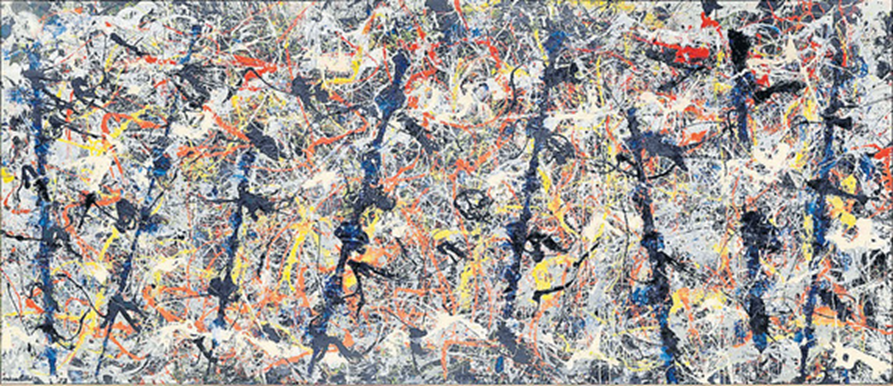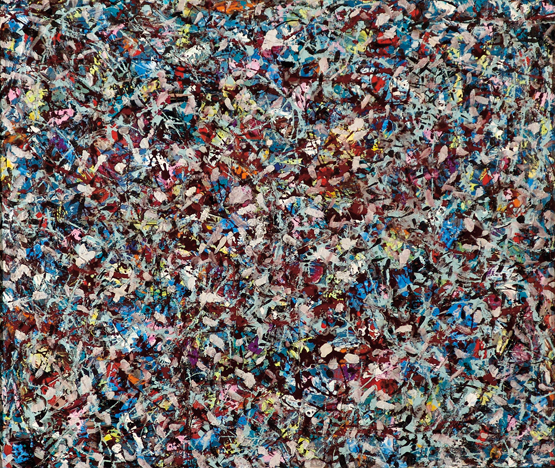Pollock, Jackson - Nigel Halliday
Abstract Expressionism
by Nigel Halliday

Jackson Pollock: Blue Poles, 212.1 x 488.9 cm, National Gallery of Australia
Abstract Expressionism has sometimes been dismissed as merely large daubs that could have been done by the proverbial ‘child of six’. But the painters themselves were deeply serious men, using painting to reach after answers to our deepest questions, and producing images far more complex and coherent than any child of six would produce.
Western art used to focus on what we worship, what is good, and how we should live. Since the Enlightenment, with the exclusion of the transcendent from people’s definition of reality, its focus narrowed down to the more fundamental questions: What is real? What am I?
This seriousness is often lost now, as canvases change hands for millions of pounds, aestheticized, made safe on the walls of smart homes and hushed art galleries. The paintings are reproduced as greetings cards and wrapping paper, and the tragedy of the life and death of Jackson Pollock or of Mark Rothko is lost in the story-telling, as if it were a television drama.
But it is worth the while of Christians seeking to understand the times, and to engage their culture with the truths of the gospel, to remember the deep seriousness of these artists – even if their suggested answers can look sadly thin.
Abstract Expressionism was a movement primarily among New York artists during and after the Second World War. They had been inspired by the works of European modernists in the 1930s, several of whom then came to New York at the start of the war. From these artists they drew lessons about the expressive potential of colour and gesture, art in a purer form, freed from subject-matter.
The current exhibition at the Royal Academy is the first major review of Abstract Expressionism in the UK for half a century. It is very clearly arranged, and helpful annotated. A few rooms are arranged thematically, bringing together the works of several artists. But a separate room is also given to each of the key artists, which is appropriate, as each was an individualist, painting quite differently from each other.
Mark Rothko and Clyfford Still
Mark Rothko and Clyfford Still are a case in point. Rothko is famous for his shimmering blocks of colour, that seem to hang like clouds. The fuzziness of the edges is vital to the effect, as they invite you to enter an undefined arena of feeling, unclouded by specificities that rational thought imposes. Rothko’s paintings share a lot with Zen Buddhism, enticing you to float away from reality into something akin to nothingness.
Clyfford Still, by contrast, produces vast areas of rough paint in deepest blue or black paint, which then seem to be torn roughly open to reveal small patches of strongly contrasting orange or yellow. As you run your eye down the jagged edges you can feel the drama. They seem to create a sense of veiling and mystery, hinting at something beyond; possibly of life flickering amidst death; or an abyss that is ready to swallow everything up. These are painters working through the Second World War, and then living in the shadow of the atom bomb and growing realization of the Holocaust. Hope must have seemed at a premium to many of them.
Jackson Pollock
The most famous of the Abstract Expressionists is Jackson Pollock, best known for his ‘drip paintings’. Happily, the exhibition includes one of the very best examples of this period of his life, Blue Poles. This painting normally lives in Australia, so this is a rare opportunity to enjoy it.
It is a mistake to think that his drip paintings were random splashes of paint. One can see from the paintings – and find it confirmed in the famous film of him at work at one of his canvases laid on the floor – that he worked in repeated patterns of movement, responding to the shape of the canvas and to the marks he had already made, gradually building up a rich texture of gestures.
It is a surprise, sometimes, when one is used to thinking of the negative side of these works – their use of chance and apparent meaninglessness – to find how beautiful they can be. The colours are rich and attractive. The skeins of thrown paint echo each other as the artist moves round the canvas.
As you look carefully, you gradually build up a sense of how it was painted, the order in which the paint layers were applied, the series of gesture by which they were applied. It is in a sense a record of Pollock’s actions, an existential moment amplified by the presence of shards of broken glass with the paint which presumably fell there during the painting. The paintings echo the belief in self-actualisation in existentialist fiction: the sense that the artist doesn’t know what life means, but feels that some kind of meaning can be asserted through just being.
Pollock, however, went further. He was influenced not just by the Expressionists but by the Surrealists, and their interest in the unconscious. Several of the New York artists were themselves involved in psychoanalysis, and were familiar with the concepts of the ego and the unconscious. But whereas Freud regarded the unconscious as an area to be approached with great caution, there being good reasons why things were safely locked up there, the Surrealists saw the unconscious as a great well of wonderment, from which new exciting emotions and experiences could be released through the means of surreal, irrational images.
From his commentary in the film of him at work, Pollock seems to have felt that, if he could paint without the control of his rational mind, then the result would be an expression of his unconscious mind. It would therefore be an expression of his deeper, inner self.
There is a real sadness in this yearning for transcendence. The artists commendably felt that there must be more to life than materialism and humanism seemed to allow. But, in a world without God, there is a wilful, almost mystical leap of faith that irrational action will put you in touch with your deeper self – and that that deeper self has any meaning anyway.
Beauty and the beast
The exhibition is therefore a mixture of the sadness of artists looking, with a degree of desperation, for meaning, but doing so in a works that are often sublimely beautiful. Lee Krasner counters the idea that Abstract Expressionism is all oversize bombast with a work that is a fraction of the size of most of the paintings in the exhibition, but delightfully rich, dense but delicate, like filigree; the paint seemingly dribbled over it with a tiny syringe.

Lee Krasner: Shattered Color, 1947
Louise Nevelson also makes beautiful assemblages of everyday articles, set within wooden boxes, a uniform coat of black paint covering absolutely everything and seeming to hold them in a unity. The works are enigmatic, because the objects have lost their quotidian usefulness.
However, as with Pollock, one is left with the question of what the works really mean. The art historian Hans Rookmaaker used to describe such works as ‘gnostic’: they claim to be gateways to special knowledge of deeper, spiritual reality – and yet they are beyond interrogation. One cannot question or reason with what they claim to reveal. One simply has to take them on trust – or not.
It is taking a leap of faith to believe that, in stepping into the bounds of the irrational, one has located genuine meaning. But the artists still express their God-given image in their creation of some very beautiful objects.
[This review was first published in Evangelicals Now, December 2016]


